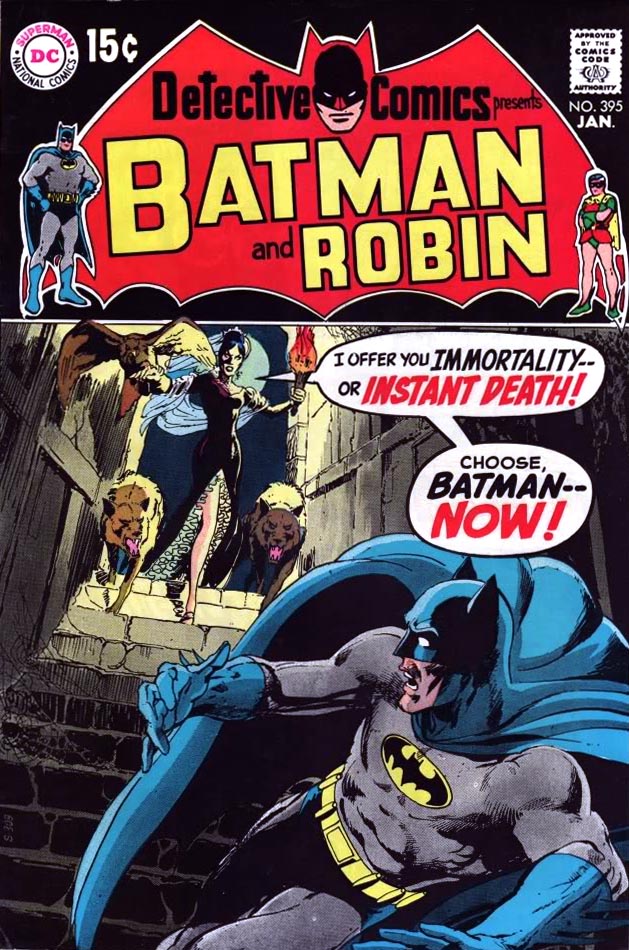Batman Goes Goth (Again)
I’ve written before about how the Batman: From the ’30s to the ’70s collection was my first sustained exposure to superhero comics. And a selective exposure it was, I’ve since realized.
E. Nelson Bridwell’s introduction described the “New Look” and television-show period of Batman comics (1964-68), but the anthology omitted nearly all stories from those years. Its 1960s section showcased the Caped Crusader’s science-fiction adventures at the start of that decade. That section included three of the seven tales that ever featured Betty Kane as Bat-Girl, leaving me with an outsized impression of her place in the overall saga.
Bridwell presented the 1970s as “the reappeance of the dark, avening figure of mystery called The Batman!!” That section started with “One Bullet Too Many” from December 1969, which showed Dick Grayson heading off to college and Bruce Wayne using forensic science to solve a murder mystery with no costumed criminals. Bruce and Alfred also moved into the headquarters of the Wayne Foundation, beginning a period of overt social activism that would culminate in a brief appointment to the US Senate. The 1970s Batman comics thus promised to become more deeply rooted in the real world.
Yet that section of the book also included the highly regarded “Secret of the Waiting Graves,” by Dennis O’Neil and Neal Adams; “Man or Bat?” introducing Man-Bat, by Frank Robbins and Adams; and “The Demon of Gothos Mansion,” by O’Neil and Irv Novick. Those are all Gothic tales of monsters, ghosts, and other spooky things. Though Man-Bat is a creation of science gone wrong, the other two tales clearly rest on the supernatural.
Which left little me confused. If the Batman comics had redeemed themselves from camp by returning him to his roots as a crime-solving detective, why was this volume showing me ghost stories? Mysteries are all about ratiocination, but the “Waiting Graves” and “Gothos Mansion” stories end with Batman realizing the limits of his deductive powers to make sense of the world.
I’ve since learned that Batman’s roots lie just as deep in Gothic horror as in detective stories. Bruce Wayne is dressed as a giant bat, after all. Among the character’s earliest adventures were fights against vampires, monsters, and other supernatural creatures. Those villains flourished again in the 1970s, and in 1982 Gerry Conway even brought the vampirical Monk and Dala from 1939 back to life. But I still prefer the detective stories.
E. Nelson Bridwell’s introduction described the “New Look” and television-show period of Batman comics (1964-68), but the anthology omitted nearly all stories from those years. Its 1960s section showcased the Caped Crusader’s science-fiction adventures at the start of that decade. That section included three of the seven tales that ever featured Betty Kane as Bat-Girl, leaving me with an outsized impression of her place in the overall saga.
Bridwell presented the 1970s as “the reappeance of the dark, avening figure of mystery called The Batman!!” That section started with “One Bullet Too Many” from December 1969, which showed Dick Grayson heading off to college and Bruce Wayne using forensic science to solve a murder mystery with no costumed criminals. Bruce and Alfred also moved into the headquarters of the Wayne Foundation, beginning a period of overt social activism that would culminate in a brief appointment to the US Senate. The 1970s Batman comics thus promised to become more deeply rooted in the real world.
Yet that section of the book also included the highly regarded “Secret of the Waiting Graves,” by Dennis O’Neil and Neal Adams; “Man or Bat?” introducing Man-Bat, by Frank Robbins and Adams; and “The Demon of Gothos Mansion,” by O’Neil and Irv Novick. Those are all Gothic tales of monsters, ghosts, and other spooky things. Though Man-Bat is a creation of science gone wrong, the other two tales clearly rest on the supernatural.
Which left little me confused. If the Batman comics had redeemed themselves from camp by returning him to his roots as a crime-solving detective, why was this volume showing me ghost stories? Mysteries are all about ratiocination, but the “Waiting Graves” and “Gothos Mansion” stories end with Batman realizing the limits of his deductive powers to make sense of the world.
I’ve since learned that Batman’s roots lie just as deep in Gothic horror as in detective stories. Bruce Wayne is dressed as a giant bat, after all. Among the character’s earliest adventures were fights against vampires, monsters, and other supernatural creatures. Those villains flourished again in the 1970s, and in 1982 Gerry Conway even brought the vampirical Monk and Dala from 1939 back to life. But I still prefer the detective stories.





No comments:
Post a Comment